Shipping focus: Capacity in the balance
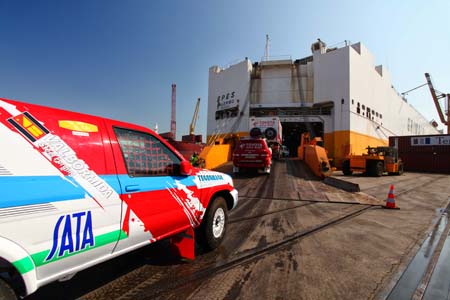 Ocean carriers face increasing trade and regulatory complexity to go with a volatile global market. However, many are investing in larger, more efficient vessels
Ocean carriers face increasing trade and regulatory complexity to go with a volatile global market. However, many are investing in larger, more efficient vessels
The balance of supply and demand for capacity is a tricky objective for ocean car carriers to achieve. For the most part, the leading carriers succeed in their efforts, but it is easy to fall short or overshoot. Tonnage demand is an unpredictable guessing game, influenced by market and regulatory changes. In 2014, for example, supply growth for ro-ro vessels generally exceeded demand, leading to empty space on board. According to Ole Gustav Eriksen, a shipping analyst at RS Platou Group, the average utilisation rate for the global car carrying fleet went from 85.3% in 2013 to 84% this past year (full capacity utilisation is considered to be 90%).
“Demand was flat, but supply grew by about 2.2%,” he says.
That even this small decline could impact the sector demonstrates how complex the ocean-shipping segment can be. In today’s market, operators face unpredictable demand along with changing trade patterns and regulations.
For example, while the routes from Japan and South Korea to Europe and the US remain at the forefront of global shipping volumes for finished vehicles, OEMs have been localising their production bases rapidly, leading to new routes and more regional flows such as between Mexico and the US or from North Africa to Europe.
There are also new, smaller trade lanes, such as exports from India to Mexico. And while China-based manufacturers have yet to emerge as ![]() major export players, several companies, both indigenous to China as well as western and joint venture brands, have plans to export to Europe and the US as well as to developing countries. Trond Sjursen, head of commercial at Höegh Autoliners, points to plans by both Shanghai General Motors and Volvo Cars China to export to the US, for example.
major export players, several companies, both indigenous to China as well as western and joint venture brands, have plans to export to Europe and the US as well as to developing countries. Trond Sjursen, head of commercial at Höegh Autoliners, points to plans by both Shanghai General Motors and Volvo Cars China to export to the US, for example.
Click on the links below to read the different articles that make up this report.
Finally, along with challenges in capacity and route management, starting in 2015 the short-sea shipping sector in particular faces cost increase in some regions as the Sulphur Emission Control Area (SECA) regulations kick in for much of northern Europe and the US and Canadian coast lines. The full impact of this change on costs and services was not fully understood even on the eve of the new regulations – but they will become clearer soon enough.
The view from Europe
The European industry remains one of the most important pillars of the vehicle shipping sector, as the region exports more than 6.5m units per year. However, years of declining vehicle sales in the European Union, as well as the crisis this year in Russia, have weighed heavily upon shipping lines.
Still, the main shipping lines are looking to increase their fleets and service. Höegh Autoliners, for example, has fairly aggressive expansion plans. In 2015, it is expecting two 8,500 CEU (car equivalent unit) post-Panamax vessels to come online, with the same fleet expansion in 2016. Höegh’s volume is up since slackening during the summer, according to Sjursen, and demand growth is expected for 2015, although it may be slightly under capacity.
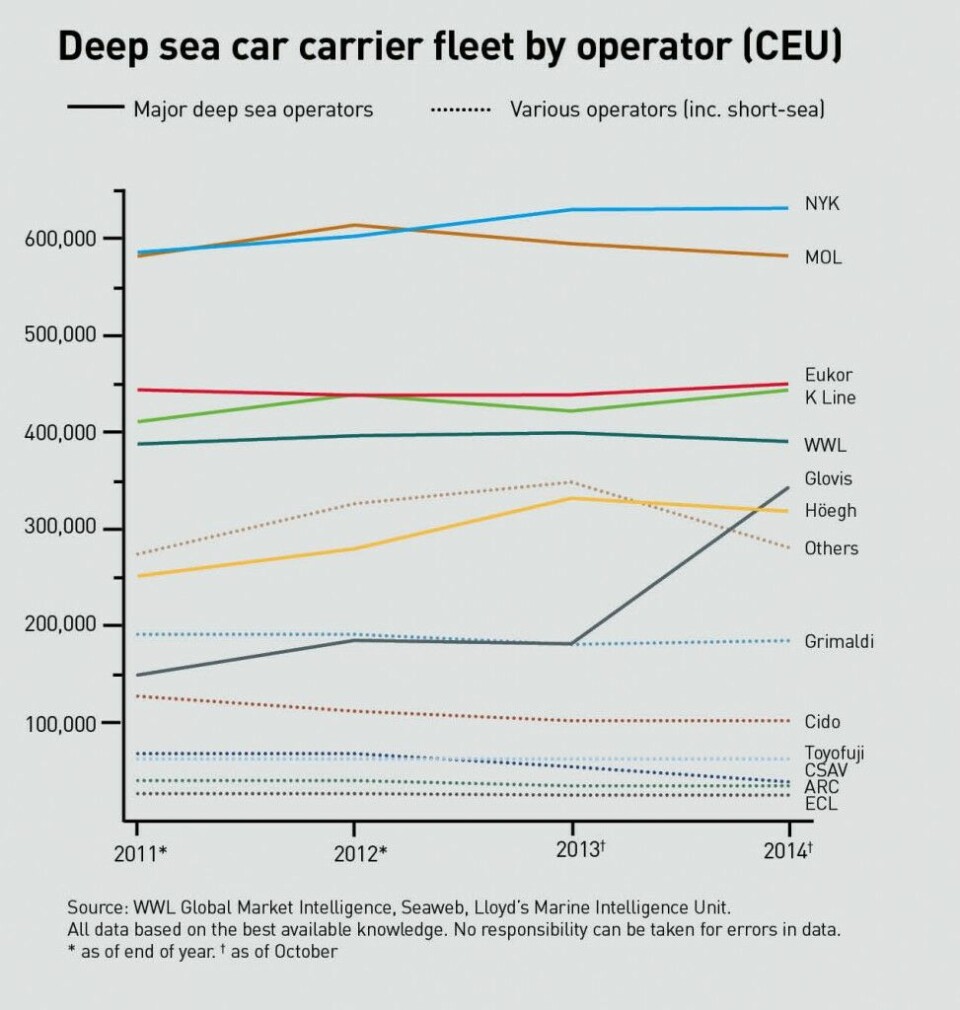
“Previously, our position was weak since GM Korea stopped exporting to the northern European continent,” Sjursen says, referring to GM’s decision to suspend Chevrolet sales in western Europe. “This put pressure on our trading systems and made it more difficult. Thus, we lost volume 18 months ago and we are working [to regain] it.”
One way that the company has been trying to improve its business is by reducing the cost per CEU, which is why Höegh has invested in larger vessels. The company is also reviewing administrative and port costs.
According to Sjursen, Höegh also plans to diversify by increasing activity in breakbulk and project cargo. “Project cargo is growing and the Middle East is a huge market for it. This is enhancing our capabilities in cost and capacity. In one year, we expect to be on par with our main competitors, such as Wallenius Wilhelmsen Logistics (WWL).”
WWL is also expecting growth and an expansion in the capacity of its fleet. Erik Nyheim, chief commercial officer, says it anticipates a 10-15% capacity increase within the next three years. The company’s new vessels will have five liftable car decks, four decks for high-and-heavy cargo, new engines and a wider effective speed range that will increase flexibility. The carrier will be introducing eight post-Panamax vessels between 2015-2017. These ships will be wider to make better use of the Panama Canal post-widening in 2016, Nyheim explains.
Nyheim says capacity is well balanced, but the company continues to be challenged by the stagnant market in Europe. Elsewhere, the market
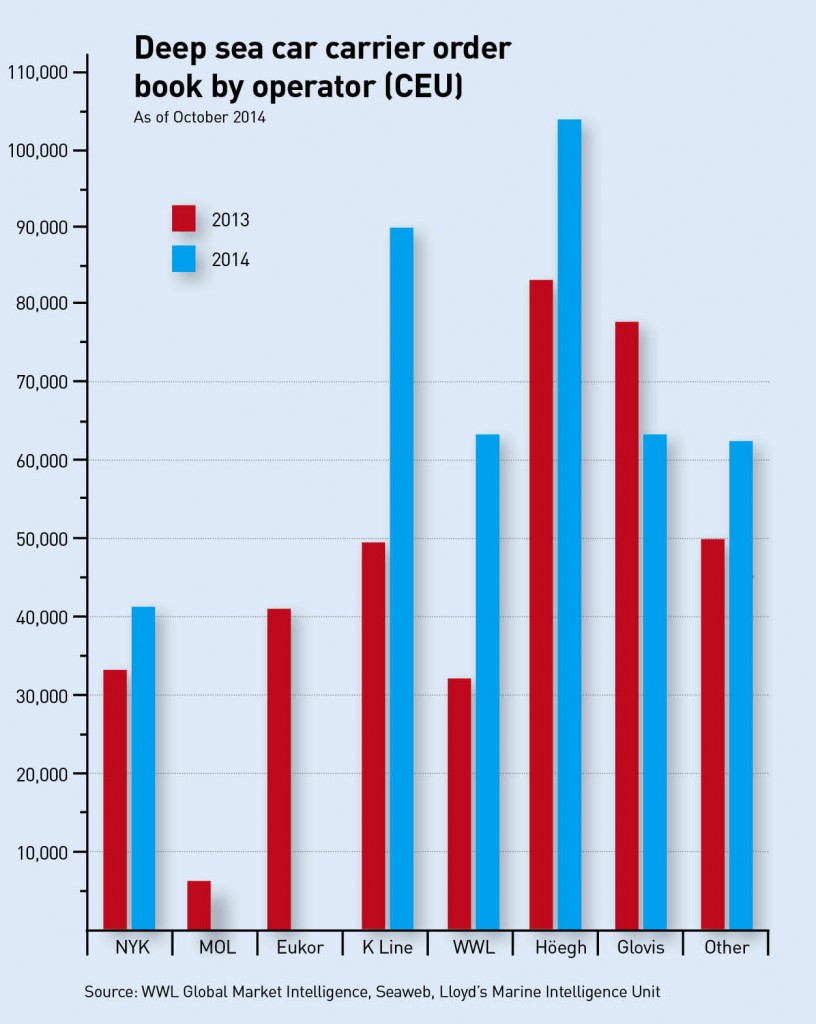
for mining equipment from Europe and the US to Australia will see some growth for the next two years. In Asia, Japan is declining, and Korea is flat, but China and Thailand are showing some increases.
“Since our capacity demand is a bit slower than we would like, we have used this time to recycle some of our older vessels,” he says.
At Grimaldi Group, Costantino Baldissara, director of commercial, logistics and operations says the Italian shipping line’s supply and demand is balanced for its North-South America and Europe-West Africa deep-sea trade. In 2014, Grimaldi received two new multipurpose vessels for its deep-sea Atlantic trade that can load up to 5,700 linear metres, including space for cars, commercial vehicles, and earth-moving equipment.
Baldissara adds that for short sea, Grimaldi’s Baltic, north Europe, and Mediterranean Sea services are also balanced.
Overall for short sea, the capacity situation in Europe is somewhat mixed. United European Car Carriers’ (UECC), Bjorn O Gran Svenningsen, head of sales and marketing, says that even if supply and demand are aligned, end-of-month peaks and poor forecasting disrupt carriers’ service plans.
Others see a more specific problem of overcapacity in segments of the European short-sea market. “Overall, and especially within the European Union, there is still too much capacity on both ro-ro vessels and ferries, which affects the profitability of operators,” says Erik Lewenhaupt, the head of external communication and branding at Swedish ferry carrier, Stena.
In 2013, Stena shipped around 3m cars; it saw moderate growth during 2014 for automotive cargo. “We have purchased a few vessels that
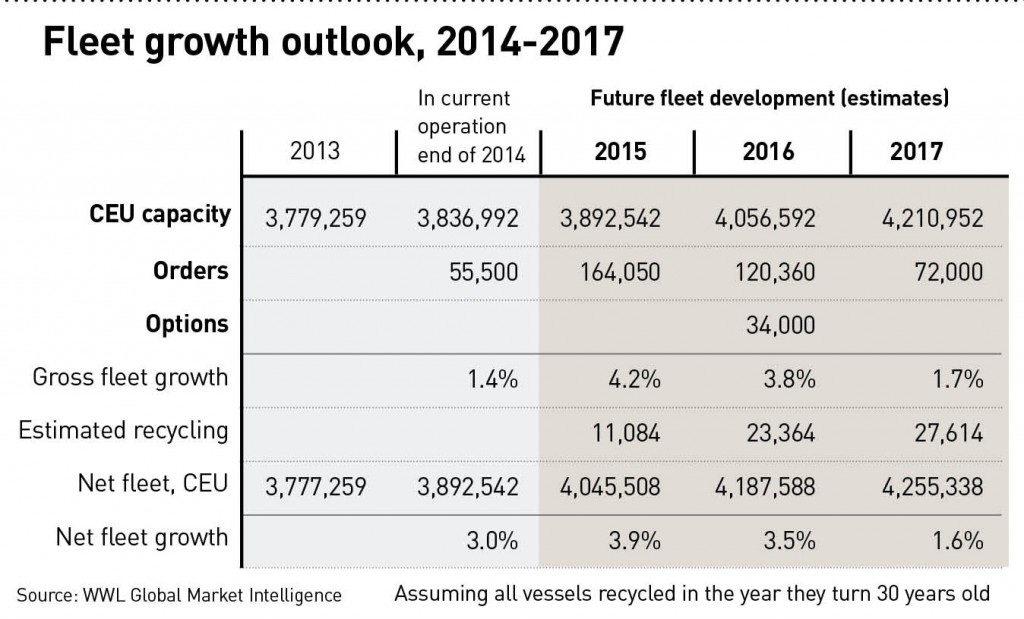
Stena RoRo operates; we now own 20 ships in addition to Stena Line’s 40 vessels,” says Lewenhaupt. “Many of these new ships we charter out; thus, the actual capacity of our lines has been flat or steady. In 2015, capacity demand will likely be relatively flat, but SECA is a question mark.”
The view from Asia
Asian carriers are playing a strong role in developing new tonnage, with substantial investment plans. K Line will deliver ten new post-Panamax vessels between the summer 2015 and 2017 to replace older and smaller vessels, increasing its carrying capacity by more than 5%. In 2014, it redeployed six larger ships and redelivered six medium-size ships to comply with the recent change in its cargo portfolio and demand for trade between the US east coast and South America.
K Line expects global demand for ocean car carriers to increase at a moderate pace globally, but for specific trade lanes, the outlook is varied. Between 2013 and 2019, K Line predicts eastbound finished vehicle trade to Asia will increase by around 8%, and westbound by around 5%. Despite the yen depreciation, Japanese exports are expected to continue to decline, perhaps by as much as 20%, according to Yasunari Sonobe, executive officer for the car carrier business (planning and development) at K Line. The carrier also expects a decline in South Korean exports of around 5% following continuing appreciation of the won and further moves by Hyundai and Kia to build more local plants.
Southeast Asia is expected to grow on the import side, and K Line expects an 80% increase, with Thailand also remaining a strong export market. The company currently operates three intra-Southeast Asia dedicated services, with vessels of 4,200 RT (revenue tonnes), 4,300 RT and 5,000 RT; it doesn’t plan to increase the number of vessels serving the region. It is likely that demand increases will be covered by shifting vessels and capacity that had been serving exports out of Japan, while also replacing smaller, older vessels.
Sonobe anticipates that growth in China will strain capacity for Asian trades, particularly out of Europe. “As long as China maintains its current economic growth, we will face some space shortages soon in the eastbound Europea-Asia trade. This trade lane is one of our core businesses. As such, we are planning to allocate the first of three new post-Panamax vessels to meet this demand,” he says.
Craig Jasienski, president and chief executive officer of Eukor Car Carriers, also points to weakness in exports to Europe from Japan and South Korea, even as exports from the EU remain strong to China. German premium brands have also increased volume to South Korea and Japan, although the numbers are relatively small.
"Project cargo is growing and the Middle East is a huge market for it. This is enhancing our capabilities in cost and capacity. In one year, we expect to be on par with our main competitors" - Trond Sjursen, Höegh Autoliners
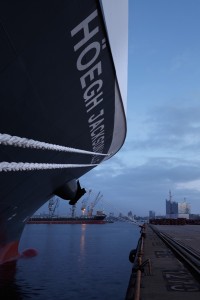 Eukor does not foresee any imminent capacity challenges, but some of its freight rates are not sustainable on their own, admits Jasienski. “If you take away the capacity driving volumes at one end of a trade, an imbalance will arise and create gaps where more costly tonnage would need to be called out,” he says.
Eukor does not foresee any imminent capacity challenges, but some of its freight rates are not sustainable on their own, admits Jasienski. “If you take away the capacity driving volumes at one end of a trade, an imbalance will arise and create gaps where more costly tonnage would need to be called out,” he says.
Short-sea business in Asia is proving to be fairly successful. Euro Marine Logistics (EML), a joint venture between Höegh Autoliners and MOL that expanded last year to Asia following its services in Europe, is seeing fast growth, according to Trond Sjursen. EML operates two vessels from Japan to Southeast Asia and coordinates with Höegh Autoliners’ deep-sea routes. “We hope to have seven or eight vessels in three to four years. We are looking to grow in China, Indonesia, and Malaysia,” he says.
Other shipping lines, including WWL, also foresee increases in Southeast Asia and from China to Southeast Asia. For example, PSA and its Chinese investor and joint venture partner Dongfeng have already said they will target Southeast Asian markets from plants in China.
The view from the Americas
Shipping lines have also seen a rise in volumes moving between Mexico and the US, as Mexico continues to produce more vehicles for regional and global export. Although the traditional export route between the US and Mexico remains rail transport, OEMs have been looking to diversify their trade routes to ensure capacity and reduce cost. Recently, carmakers including Honda, Ford, General Motors, Nissan and Mazda have all added or increased short-sea shipping services from Mexico to ports in the US and Canada.
Growth is expected to increase with the planned construction of more plants, including for Mercedes-Benz, Infiniti, BMW, Audi and Kia. Many carmakers are increasing their exports not only to the US from Mexico, but also global markets including South America. Audi plans to build the new Q5 in Mexico, which it will also export to Europe, for example.
Höegh has seen strong growth out of Mexico, and Sjursen is interested in expanding further. WWL is also expanding shipping services in the Gulf of Mexico, both for US and Mexican ports to support the OEMs.
Elsewhere, there have been declines in trade, particularly for Brazil and Argentina, both of whose markets have dropped this past year.
SECA variables
For several years the shipping sectors in Europe and North America have been focused on upcoming changes to sulphur limits in fuel, which had been mandated by the IMO in 2008 and later adapted by the US and EU authorities. From January 1st 2015, ships in the North Sea and Baltic Sea, as well as the US and Canadian coasts, will not be able to use fuel that contains more than 0.1% sulphur. Even on the eve of this change, there were many questions over what the final cost and service impacts of the so-called SECA zones would be on ro-ro and short-sea shipping. Bunker fuel is expected to increase by at least 10%, while carriers have several options available, including a shift to marine gas oil, working on ultra-low-sulphur bunker fuel, scrubbers, and alternative fuels such as liquefied natural gas (LNG). Either way, costs are expected to rise.
“SECA will be a market changer – for good as well as for worse. It is impossible to predict,” says Poul Woodall, director, environment and sustainability at DFDS Seaways. “However, it is safe to assume that certain volumes that are currently moving by sea will switch to land-based transport and that certain commodities will be sourced from new locations.”
There will be lower volumes on some routes, but demand will switch to others, suggests Woodall. The effect on overall markets will depend on how the market reacts to the regulations. DFDS, for one, has been proactive ahead of the regulations, investing in technology designed to remove the extra sulphur content from fuel. “Several years ago, we invested around €100m ($123m) in retrofitting a number of our vessels with exhaust gas cleaning systems, the so-called ‘scrubbers’. Currently, we have 11 vessels on the water fitted with this equipment,” he says.
DFDS Seaways expects market conditions to be difficult and unpredictable, partly as a result of the regulations. “Especially in the coming years, we expect to see quite a turbulent market in northern Europe as the full effect of the cost increase due to the new sulphur regulations [manifests],” says Woodall.
"SECA will be a market changer – for good as well as for worse. It is impossible to predict. However, it is safe to assume that certain volumes that are currently moving by sea will switch to land-based transport and that certain commodities will be sourced from new locations" - Poul Woodall, DFDS Seaways
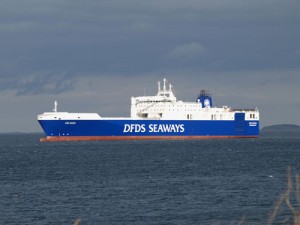 As a result of this volatility and difficult forecasts, DFDS has taken a cautious approach to expanding its fleet and services, including the closure of several lanes. “We added two new builds to our fleet in 2014, but we have also announced the closure of routes in the Baltic, the North Sea and the English Channel,” says Woodall.
As a result of this volatility and difficult forecasts, DFDS has taken a cautious approach to expanding its fleet and services, including the closure of several lanes. “We added two new builds to our fleet in 2014, but we have also announced the closure of routes in the Baltic, the North Sea and the English Channel,” says Woodall.
For short-sea operator UECC, Svenningsen says the regulations will not affect capacity directly, but there could be a general reduction as old and inefficient vessels are taken out of the market. “Our fleet has changed from traditional, small, short-sea vessels to a mixed and flexible fleet of small PCTCs (pure car and truck carriers),” Svenningsen says. “We also have two new LNG-operated vessels under construction.”
Höegh’s Sjursen agrees that SECA will not influence capacity, but will increase spending. He adds that a fuel-saving programme will help to absorb some costs, however, the company “will have to pass some costs on to customers through changes in bunker clauses,” he says.
At Stena, the company’s executives believe the cost increases that result from the regulation could reduce demand. “The regulations will likely have a negative effect on the industry within northern Europe,” says Erik Lewenhaupt. “Industry-wide, we expect an average 15-20% increase in price for freight customers in the SECA area. The estimated difference is about $4-5/MT per 40ft container from the inner Baltic Sea to Rotterdam, which is a big extra cost.”
Sizing up
Over the past few years, a trend has been obvious towards the ordering of larger vessels as operators seek to reduce the costs per unit of their fleet. The global ro-ro fleet is increasingly weighted toward these vessels and the current order book consists mainly of vessels that are at least 7,000 CEUs, as shipping lines look to take advantage of the widening of the Panama Canal in 2016. In fact, hardly any small or medium-sized vessels have been ordered in the past six years, according to Eriksen at RS Platou Group. The smaller vessels in use are considerably older and therefore face competition from modern, large vessels operating on regional trades, he adds. The current fleet, globally, is quite young, averaging ten years with a 30-year lifespan.
While the use of larger ships may be good for costs per unit, there are some potential services issues. As trade lanes become more fragmented and grow in different regions, fleets or larger ships may have to make more stops or rely more on transhipment. Already in Asia there are signs that some ports could emerge as large transhipment hubs, including the port of Hambantota in Sri Lanka.

The longer lead times could be a worry to some. Rising fuel costs have already forced operators to reduce the speed of their vessels, which increases tonnage demand as more vessels are needed to transport a given volume. According to RS Platou figures, the ro-ro sector has registered an average 6% reduction in fleet speed over the past four years.
The potential good news for carriers is that over the next three years, RS Platou expects demand growth to outpace supply growth, with fleet capacity utilisation remaining stable and possibly improving to 86% by 2017 – although some factors will be hard to predict.
“The risk to demand growth is that transplantation of production from Japan and Korea to overseas markets may increase beyond current predictions,” says Eriksen. “Furthermore, 2017 fleet growth estimates are premature; there are only five vessels scheduled for delivery, although we have assumed 20 new vessels will launch that year. We estimate fleet growth in 2015 and 2016 will be 2.5% to 3% each year.”
In a changing market, ocean car carriers are focused on achieving economies of scale in the deep-sea market through the continued introduction of larger post-Panamax vessels and ones suited for the Panama Canal expansion in 2016. But the focus isn’t solely on the deep-sea market, with attempts to grow short-sea services in regions like such as Southeast Asia and North America. Short-sea carriers must also contend with the effects of the SECA regulations. New opportunities in China, Asia and elsewhere are helping to balance the slower development in other regions, but the challenges are many, and the need for flexibility is as pertinent as ever.





